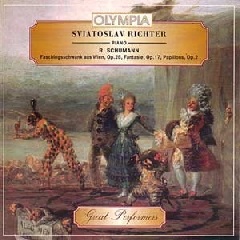Robert Schumann - Faschingsschwank aus Wien, Fantasie, Papillons (1962)
Robert Schumann - Faschingsschwank aus Wien, Fantasie, Papillons (1962)

Faschingsschwank aus Wien, Op. 26 01 - I. Allegro 02 - II. Romanze 03 - III. Scherzino 04 - IV. Intermezzo 05 - V. Final Fantasie, Op. 17 06 - I. Durchaus phantastisch und leidenscaftlich vorzutragen 07 - II. Massig - Durchaus energisch 08 - III. Langsam getragen - Durchweg leise zu halten 09 Papillons, Op. 2 Sviatoslav Richter - piano Tracks 1-5 Live recording, 1962 Tracks 6-9 Studio recording, 1961
Robert Schumann, born in Zwickau in 1810, died in an asylum in Endenich in 1856 totally insane. Most likely he was bipolar and as there was no lithium treatment in his day the manic-depressive condition was lumped in with all the other lunacies. His bipolar condition had a great effect on his music and also his personal life.
As an 18 year old he enrolled in Leipzig University and at the same time commenced piano lessons with Freidrich Wieck. It was there that he met Wieck's daughter Clara and as she grew into a lovely young woman they fell in love. Wieck, sensing Schumann's mental instability, did his best to end the affair and they had to wait until 1840 until they could legally marry without Wieck's consent.
Much of Schumann's early music is about his affair with Clara and the C major Fantasy is the epitome of this. The rest of Schumann's life is well known. He followed what is a typical path for the manic depressive at the time; reliance on alcohol, times of high mania and low depression until his eventual confinement, when Clara could no longer look after him. The Fantasy in C major is all about Clara and also reflects Schumann's mood swings. At the time of its composition in 1836 he and Clara had been forcibly separated by her father and the first movement is both a passionate railing against fate and desperate outpouring of his love for her. It's interesting that the leitmotif used for the first movement comes from Beethoven's song cycle "To the Distant Beloved" - no coincidence methinks.
The second part of the Fantasy is in the form of a march and Clara herself described it as a "triumphal pageant of warriors returning from battle". Schumann had defeated the demons of depression and was returning to claim his prize. The Finale is one of the most hauntingly beautiful pieces in the piano literature. Is this Clara and Robert reunited and as one?
The Fassingsschwank is Schumann's impressions of a carnival he attended in Vienna in 1838. It contains some of his most brilliant and witty writing and is in turns exciting and reflective. The scintillating scherzino is a real finger breaker for pianists and the finale is reminiscent of the last work in the Op 12 Fantasiestucke.
Papillons is an early work (1832) and is a warm up for Carnaval Op 9. Indeed you can hear one of its the themes early on in Op 2. All the 12 movements are in dance form, mainly waltzes and ends with the famous 17th century "Grandfather Dance" As usual, Schumann mixes the tempo and the mood to great effect. Sviatoslav Richter was arguably the greatest pianist of the twentieth century. Born in Zhitomir in the Ukraine in 1915 he was largely self taught despite the fact that his father was a concert pianist and music teacher. Getting the job as repetiteur at the Odessa Opera at age 15 he finally gave his first solo recital of works by Chopin for his friends in his 19th year.
He never looked back. Later, he came under the guidance of Heinrich Neuhaus at the Moscow Conservatory who also had Emil Gilels in his group . Neuhaus realised that technically he had nothing to teach Richter but in his role as mentor he helped him change his sound. Neuhaus was also a legendary performer of Schumann and Richter obviously learnt much from his father figure and the fact that Richter was one of the great Schumann interpreters is probably due to Neuhaus' influence. Richter's repertoire and his technique are legendary we hear him at his peak on this CD. He died in Moscow in 1997.
This is one of the absolute gems in the recorded archives of the piano. The Fantasy was recorded in Abbey Road studios in 1961. It is a peerless performance by Richter whose sensitivity to tempo, tonal colour and changes of mood are inspirational. The desperation of the opening movement is wonderfully captured by Richter who reveals Schumann's torment at the separation from Clara. The triumphal march then leads into the nocturne-like finale where Richter at his most tender and reflective, the final chords quietly dying away.
Fassingsschwank is a piece I never really liked until I heard Richter play it. It 's the way that he contrasts the separate pieces along with his prodigious technique that makes it work such a wonderful performance. He makes some of the passge work sound so easy and natural where other pianists tend to lumber along trying to make their fingers catch up with the music.
His Papillons is no less inspired and once again it is Richter's ability to make a set of seemingly disparate short pieces become one coherent whole. Both these works were recorded live in Italy in 1962.
This is a budget priced disc and why EMI never made it part of their Great Recordings of the Century series is beyond me. So, EMI's loss is definitely our gain. This is a must for all pianophiles. Some rate Ricter's live Prague Fantasy from 1956 as slightly better but the difference is minimal. However the sound of the EMI is infinitely superior and is the obvious choice. ---Holden, good-music-guide.com
download (mp3 @320 kbs):
yandex 4shared mega mediafire uloz.to cloudmailru uptobox ge.tt








